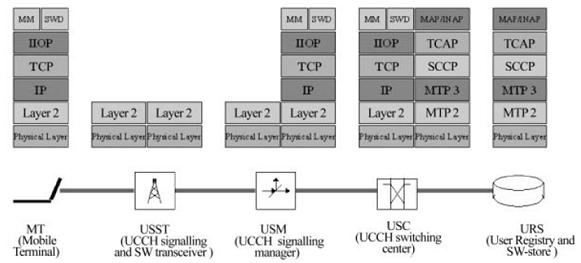
Isfahan University of Technology
Protocols and Network Aspects of SDR
H. Narimani
course project spring 2007
| |
| Home |
| Refrences |
| Relevant Sites and Projects |
| About Us |
| A Global or Universal Channel | |
The UCCH concept, not only tackles the air interface aspect, like the bootstrap and NACCH proposals, but looks beyond these into the signaling backbone network and the required protocol stacks. It is intended is to establish a signaling backbone, or bridge, to support software communication functionality between the different traffic network types. UCCH includes the definition of a support network topology, the necessary network entities, and the appropriate protocol stacks for these network entities. The UCCH network topology includes signaling applications to perform a number of signaling tasks, including:
To cope with these demands, the UCCH control infrastructure consists of a OSI-like protocol stack containing an application layer, a transport and network layer, a link layer, and a physical layer. The different protocol entities within this signaling/support infrastructure address different parts of the underlying UCCH network; some messages need to be processed in each of the network nodes while other messages require direct end to end connectivity (e.g. software requests involve only the terminal and the software server while all nodes in-between are transparent to this message exchange). The protocol stack and network structure of the UCCH are depicted in the figure below.
|
|
|
|
UCCH signaling protocols for software download and mobility management are documented in 'A minimum air interface implementation for software radio based on distributed object technology' by K. Moessner. See also the next page, "Functional Rrequrements of the UCCH". |
|
see also : |
|


